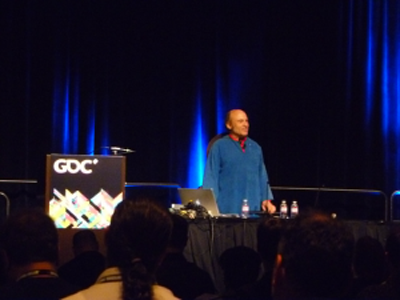GDC大会观点:“玩家会怎么做”是游戏设计第一原则
日前电脑游戏开发者大会创始人、游戏设计师克里斯·克劳福德(Chris Crawford)在2011年的GDC大会上发表了激情的演讲。据游戏邦了解,他在演讲中谈到了游戏行业目前的发展阶段,以及未来的发展方向。
克劳福德发现,早期的游戏内容主要针对微型计算机而设计。游戏一般都会搭配书籍进行销售,想要玩游戏,玩家得读懂书中的相关内容。
在早期还有人用纸和笔编写软件,“当然,你不仅要熟记这些规则,同时还得完全理解。最难的部分就是用十六进制进行倒推,只有这样你才能完成循环运算。”
但是随后出现了雅达利的Stella/VCS。据游戏邦了解,Stella/VCS可以和电视机对话。15年前的CRT电视机就配置了屏幕缓冲器,你可以通过扫描线把屏幕缓冲器编写到电脑内存中。VCS更为原始,“Stella内置一个线路缓冲器,你可以存储图形图像的扫描线。”
“在Stella绘制当前扫描线的时候,你得为下一条扫描线准备数据,并在Stella追踪下一条扫描线前,把所有数据输入电脑中。在绘制当前扫描线的时候,你得罗列出下一条扫描线的所有组成要素。”
到了现代,我们从微型计算机步入了家庭计算机时期。克劳福德表示,“大家应该都还记得苹果二代(Apple II),但其实还有其他例子。虽然很多人没用过Commodore PET和Tandy TRS-80,但他们对这两款电脑也略有所知。”
游戏邦获悉《Tanktics》是克劳福德曾经的作品,主要运行于早期的微型计算机,他同时也为Commodore PET制作了一个端口。“你把所有的零件收集起来,放进一个拉链袋,然后在袋子上扎一个孔,最后零售商把袋子挂在墙上。这面墙就集中了整个世界的软件。”《Tanktics》售价15美元,共卖出了150份,“这款游戏比今天的任何一款游戏更有市场覆盖率。”他开玩笑称,“1978年12月30日,我把第一份《Tanktics》卖给了一个叫比尔的家伙……我想不起他姓什么了。”
1984年,巨大的灾难发生了。克劳福德表示,“这场灾难的严重程度着实让人难以估算,大约有95%的游戏工作者丢了饭碗。情况很糟糕。许多人找不到新工作,因为同时有太多人涌入求职市场了。”
“那时,想要成为一名游戏程序员,你要有足够的魄力,”克劳福德表示,“你得独揽所有的事情!在游戏行业,每个人基本上都是独立工作,相互之间的交流很少。”这就是克劳福德1988年创办电脑游戏大会的原因。他开玩笑称,“我做梦也没有想到大会能取得成功,现在游戏开发商们显然不再独来独往了!”
克劳福德表示,“当时有很多糟糕的游戏。真的是很糟糕的游戏,但游戏种类比较多。”在他看来,现代游戏会比较单一。“当游戏投资高达数百万美元时,设计师就不敢太标新立异。”
克劳福德在演讲结尾重申了他编写软件的第一原则:“在设计游戏的整个过程中,你都要不断地问自己‘玩家会怎么做’?”据游戏邦了解,克劳福德认为这点很重要,因为玩家并不观看游戏,也不阅读游戏或倾听游戏,他们只玩游戏。
他注意到了新旧游戏之间的相似之处,在这些游戏中,平台游戏、射击游戏和策略游戏的核心理念变化都不大。克劳福德称,“在过去30年中,玩家的行为并没有发生什么变化。但我并不是说现代游戏不比过去的游戏强多少。”
现代电脑比以前的电脑快了好几亿倍,开发工具也比以前的方便很多。《光晕》(Halo)会比《Combat》好上亿倍吗?克劳福德表示,“我不会回答这些问题,但这些问题值得我们思考。”(本文为游戏邦/gamerboom.com编译,转载请注明来源:游戏邦)
GDC 2011: CGDC Founder Chris Crawford: Ask Yourself ‘What Does The User Do?’
In an impassioned talk at GDC 2011 on Thursday, Computer Game Developers Conference founder and game designer Chris Crawford discussed where the industry has been, and where it’s gone now.
Going through the early micro computers, he noted that while primitive, games were made for these things. Books would be released with games in them, and you’d have to code them in in order to play.
One wrote software with pencil and paper, in Assembly. “Of course you had to memorize the rules, but you also had to compile it in your head. The hardest part about it was counting backward in hexadecimal so you could do your loops.”
But then came the Atari Stella/VCS. It could talk to a television set. For CRT televisions, 15 years ago you had a screen buffer, and you’d write it into the ram with scanlines. But the VCS was even more primitive. “What we had with Stella was a line buffer,” he began. “You could store one scanline of graphics imagery.”
“And while it was drawing that scanline, you had to prepare the data for the next scanline, and get it all in there before the next line is traced. You had to specify all the components of that scanline while the previous one was being drawn.”
In the modern era, we went from micro computers to home computers. “The obvious one you all remember is the Apple II, but there were others,” said Crawford. “Like the Commodore PET and the Tandy TRS-80, commonly known by people who didn’t own one as the trash 80.”
He had a game called Tanktics, which he had made for previous microcomputers, and he made a port for the Commodore PET. “You took all the pieces, you put that inside a ziplock bag, punched a hole in it, and the retailer hung it up on the wall,” he said. “One wall would be the entire software from the entire world.” He charged $15, and sold 150 copies, “which probably represents a larger market penetration than any game today,” he joked. “I sold my first copy on December 30 1978 to a guy named Bill…can’t quite remember his last name.”
In 1984, the great catastrophe came. “That was a catastrophe whose magnitude is difficult to appreciate,” he said. “About 95% of people working in games lost their jobs. That’s how bad it was.
And many of them couldn’t get new jobs because so many people were dumped on the job market at the same time.”
“Back then to be a game programmer, you had to be a hero,” said Crawford. “You had to do everything! People in the game industry were basically working alone. We didn’t know each other.” That’s why he founded the conference in 1988. “And it seems as though I’ve succeeded beyond my wildest dreams, because you are certainly not alone right now!” he joked.
“There was a lot of crap back then. Really bad games, but there was also a lot of diversity,” he said. Modern games seem to be less diverse, in his estimation. “When you’re putting millions of dollars into a game, you can’t afford to be too creative.”
Crawford closed by restating his first law of software development: “Whenever you sit down to design a game, throughout the entire process, you must repeatedly ask yourself ‘What does the user do?’” He says this is important, because players don’t watch games, they don’t read them, they don’t listen to them, they play them.
He noted similarities between old games and new, where the core concepts of platformers, shooters, and strategy games haven’t changed much. “What the player does has not changed in 30 years,” he said. “I want to be very careful here. I’m not saying that modern games are no better than ancient games,” he added.
Still, modern computers are billions of times faster, and tools are much more friendly than they were before. Is Halo billions of times better than Combat? “I’m not going to answer those questions,” he posed, “but you should contemplate them.”(Source:gamasutra)









































